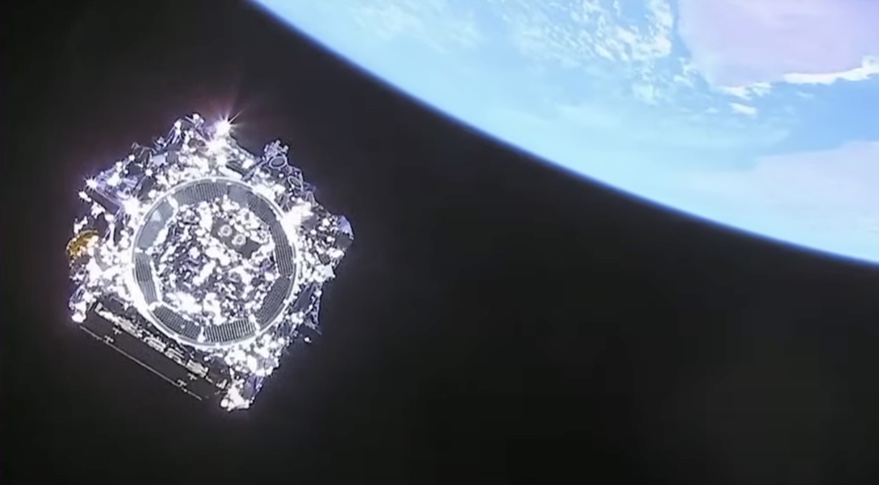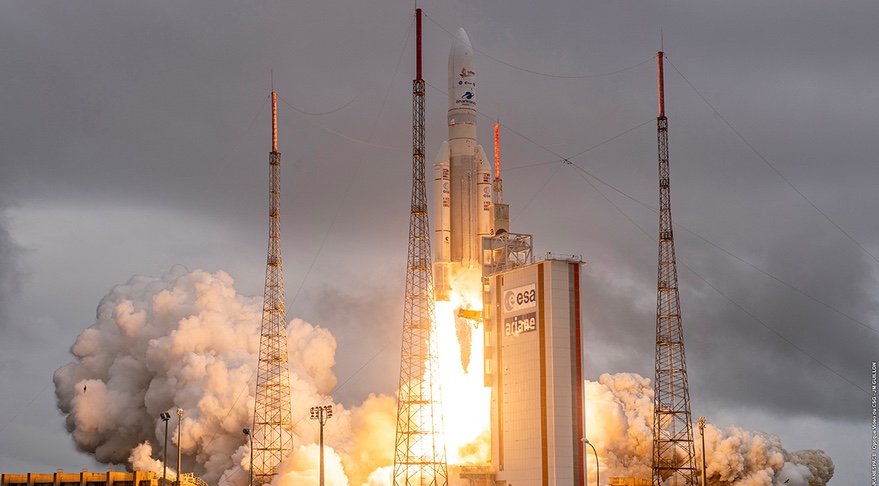SANTA FE, N.M. — A space telescope that will peer deeper into the universe than any other is on its way to its destination beyond the moon after a long-anticipated launch Dec. 25.
An Ariane 5 lifted off from the European spaceport at Kourou, French Guiana, at 7:20 a.m. Eastern. The James Webb Space Telescope separated from the rocket’s upper stage 27 minutes after launch.
Controllers confirmed that, minutes later, the 6,160-kilogram spacecraft deployed its solar array, the first in a long series of deployments for JWST. The solar array was one of the most critical ones, allowing the spacecraft to generate power.
The next key event will be 12.5 hours after liftoff, when the spacecraft performs a course correction maneuver called MCC-1a. That maneuver, and a second smaller one called MCC-1b two days after liftoff, will send the spacecraft to the Earth-sun L-2 Lagrange point, 1.5 million kilometers from the Earth, arriving there 29 days after launch.
Over the next two weeks, JWST will conduct a series of deployments to unfold into its final form. In the first week, controllers will direct the deployment of the spacecraft’s sunshield, a structure made of five layers of Kapton material the area of a tennis court that will keep the telescope and its instruments cold enough to conduct infrared observations. In this second week, the telescope’s mirrors, including its 18-segment primary mirror 6.5 meters across, will lock into place.
That schedule is subject to change, project officials cautioned in the weeks leading up to the launch, depending on the progress of the deployments and any issues that come up. JWST has 344 single-point failures, 80% of which are in deployment systems, but those officials said they have various options to address any problems that come up during deployment.

Once deployed, scientists and engineers will spend months commissioning the telescope, including aligning its optics, and then its four instruments, a process that will take about six months to complete. “As the project manager, I won’t breathe a sigh of relief until we declare we’re operational 180 days after launch,” Bill Ochs, JWST project manager at NASA’s Goddard Space Flight Center, said at a briefing in November.
At that point, astronomers will finally be able to capitalize on the $10 billion spacecraft, which until now was primarily known for years of development delays and billions of dollars of cost overruns that affected other NASA science programs and, at times, threatened the flagship astronomy mission with cancellation.
The four instruments on JWST, including contributions from the European Space Agency and the Canadian Space Agency, will study objects ranging from bodies in our own solar system to the first galaxies to form after the Big Bang. Other key science goals include studies of stellar and galactic evolution and characterization of exoplanets, including those potentially like the Earth.
“What are we going to do with this great telescope? We’re going to look at everything there is in the universe that we can see,” said John Mather, JWST senior project scientist at NASA Goddard who won the Nobel Prize in physics for studies of the cosmic microwave background.
Astronomers and others are optimistic that JWST will be able to, at long last, fulfill the lofty expectations set for it. “This is a once-in-a-generation event,” said Pam Melroy, NASA deputy administrator, at a Dec. 21 press briefing. “This is a high-risk and a very high-payoff program. We’ve done everything we can think of to make Webb successful, and now we just need to go do it.”
“This space telescope has been decades in the making and, as with most extraordinary projects that are transformative, there have been some speed bumps, there have been setbacks along the way,” NASA Administrator Bill Nelson said at that briefing. “This is the kind of a mission that only NASA and our partners can carry out. It’s going to give us a better understanding of our universe and our place in it.”
